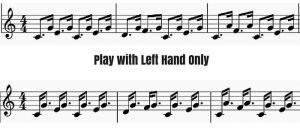 Do you have a need for speed? Piano teacher Ryan C. shares the best piano finger exercises below that will help you work your way towards extremely fast piano playing…
Do you have a need for speed? Piano teacher Ryan C. shares the best piano finger exercises below that will help you work your way towards extremely fast piano playing…
What makes a great pianist fun to watch? Is it his or her sense of musicality and his or her ability to play gorgeous music with apparent ease? I think both.
However, there is another skill that really makes a pianist great…speed!
Have you ever watched an amazing pianist play ridiculously fast and wondered to yourself: “How in the world does he or she do that?”
I’m here to give you some top tips for how to play piano faster. These strategies will help you develop strong muscles and dexterity in your fingers. And, like with anything, the more you practice, the more your endurance strengthens.
Quick tip: Remember that tone quality should be your primary focus when you’re learning piano and that too much speed too soon can oftentimes be detrimental to learning.
Note: If you’re more of a visual learner, check out the video where I walk you through each exercise.
5 Piano Finger Exercises to Play Piano Faster
Ready to learn how to move hands faster on piano? Let’s take a look at some must-try exercises!
- Be aware of your thumbs.
- Play with finger staccato.
- Block scale-chords-passages.
- Play with alternating rhythms.
- Practice your scales and arpeggios daily.
1. Be Aware of Your Thumbs
I’ve noticed in my own playing and in my students playing that sometimes our thumbs tend to be lazy. This can be unconscious so being aware of your thumbs can make a huge difference.
Specifically, when doing scales, the thumbs should cross under the hand and prepare the next note as soon as they are able to do so.
For example, if you were playing a D Major ascending scale with your right hand, you would want to play the note D with your thumb, and E with your index finger.
Immediately after you play the note E, cross your thumb under your hand and prepare near the note G.
It doesn’t necessarily need to be sitting on the key G, but it should be moving up the keys so that it will be prepared when you need to play it next.
Likewise, if you were playing the same scale in a descending pattern with your left hand, you would perform the same task, but simply would be playing the scale in reverse.
Practice the motion of playing your thumbs, then index fingers, then prepare your thumbs again. Do this multiple times each day, if possible.
I can’t emphasize enough how well this piano finger exercise works. It may seem superfluous, but it absolutely makes a difference.
2. Play with Finger Staccato
This is one of the best piano finger exercises that actually takes very little time to figure out.
In essence, you’ll play notes of your passage or notes of a scale in a staccato that comes primarily from your finger.
You’ll want to avoid using your arm or any unnecessary muscles when doing this.
When doing this piano exercise, try to mentally challenge yourself to use as few muscles as possible. See just how much force it takes to push down the key.
You’ll be surprised to find that it actually takes very little force at all. Be aware of what your hand is doing and try to play only from your fingertip.
3. Block Scales-Chords-Passages
This is an awesome exercise for improving both scale speed and chord recognition. Suppose you have a section of music that looked similar to the section of a Mozart sonata below.
Rather than playing the left hand as separate notes, play each measure (and each chord change) as a blocked chord.
Not only will you be able to identify the notes you’ll need to play with greater ease, but you’ll also have a better understanding of the harmony of the piece.
This same technique can also be applied to scales, but it takes slightly more practice to do so. When doing so with scales, you’ll want to play every finger simultaneously except for your thumbs, which will act as pivot notes and should be prepared early like we were doing in the first exercise.
4. Play with Alternating Rhythms
This exercise is very simple but provides great results in terms of how to play piano faster. If we look at the left hand in the Mozart piece from the previous example, we’ll see that it’s playing an Alberti bass pattern (alternating bottom – top – middle – top) and also has even eighth notes.
Instead of actually playing the notes as even, change the rhythmic values of the left hand to variations of dotted eighth and sixteenth notes.
5. Practice Your Scales and Arpeggios Every Day
It seems like one of the more rudimentary piano finger exercises, but it really makes a difference. My students who practice their scales every day can play faster than my students who don’t. They can also play with more musicality because they aren’t struggling to figure out notes.
Now It’s Your Turn to Try These Piano Finger Exercises
I hope that these piano finger exercises will help you be well on your way to extremely fast piano playing! I do these finger exercises every day and I have seen substantial improvement in my playing speed from before I started them.
If you want some extra help, you can always work with a private piano teacher who can provide customized lessons for you.
Please comment below if this article helped you in any way or if you have any questions. I’m always excited to hear feedback!
 Post Author: Ryan C.
Post Author: Ryan C.Ryan C. teaches piano, ear training, and music theory. He is a graduate of San Diego State University with a B.M. in piano performance. Learn more about Ryan here!
Brooke Neuman


